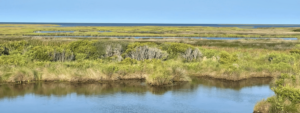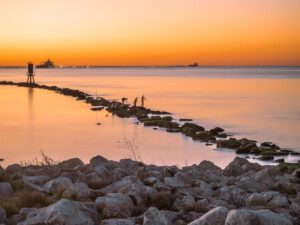
The Importance of Living Shorelines for Coastal Cities in the U.S.
As we get close to wrapping up NOAA Habitat Month 2023, we wanted to take a deep dive into one of our favorite types of habitat – living shorelines. A greener, more sustainable solution to traditional grey infrastructure, these nature based shoreline solutions can tackle a host of problems while also providing critical habitat for fish and wildlife.
Coastal threats such as erosion, rising sea levels, and intensifying storms are accelerating the need for shoreline restoration and posing a serious threat to both ecosystems and communities.
To combat this, living shorelines provide a soft, nature-based alternative to traditional hardened structures like seawalls or groins. They incorporate organic materials, such as plants, oyster shells, and sand, and can also include small-scale engineered structures. The efforts we make today in constructing living shorelines will yield lasting benefits for both human communities and the wildlife that share our coastal homes.
By nurturing diverse and robust ecosystems, living shorelines do more than just shield us from the immediate threats of erosion and flooding. They contribute to the larger environmental equilibrium, supporting fisheries, preserving the natural beauty of our coasts, and enhancing resilience to future environmental challenges.

Here are three living shoreline strategies that U.S. coastal cities can use for effective shoreline protection:
1. Marsh Creation and Restoration: Marshes are vibrant ecosystems brimming with life. They serve as nurseries for many species of fish and shellfish, offering shelter and ample feeding opportunities. The vegetation in marshes provides a home for nesting birds and acts as a refuge for small mammals. As we restore and create marshlands, we’re not just defending our shorelines, but also bolstering these critical habitats, supporting the intricate web of life that depends on them.
2. Oyster Reef Construction: The value of oyster reefs extends beyond their physical barrier function. Oyster reefs are hotspots for biodiversity, providing habitat, food, and nursery areas for a multitude of marine organisms. As filter feeders, oysters improve water quality by removing particulates, excess nutrients, and contaminants, making the surrounding water more hospitable for other marine life. The complex structure of an oyster reef offers hiding and foraging opportunities for various species of fish and invertebrates, enhancing local biodiversity.
 3. Living Breakwaters: By incorporating biological material, such as oyster shells, living breakwaters become more than just a shoreline protection measure; they serve as habitat and food source for various forms of marine life. The crevices and sheltered areas in these structures provide safe spaces for small fish, invertebrates, and juvenile organisms, protecting them from larger predators and harsh environmental conditions. Over time, as the breakwaters develop a rich coat of algae and other marine life, they become attractive feeding grounds for numerous species, including migratory birds.
3. Living Breakwaters: By incorporating biological material, such as oyster shells, living breakwaters become more than just a shoreline protection measure; they serve as habitat and food source for various forms of marine life. The crevices and sheltered areas in these structures provide safe spaces for small fish, invertebrates, and juvenile organisms, protecting them from larger predators and harsh environmental conditions. Over time, as the breakwaters develop a rich coat of algae and other marine life, they become attractive feeding grounds for numerous species, including migratory birds.
Check out our Coastal Restoration Toolkit for more ways to protect your coast!
Living shorelines represent a crucial step forward in the way we approach coastal protection. Beyond just holding back the sea, these methods work with nature, promoting biodiversity, improving water quality, and enhancing the resilience of our coasts in the face of climate change. They’re not just a choice; they’re an imperative for the sustainable future of our coastal cities.
As we navigate the challenges of the 21st century, embracing living shorelines gives us a chance to rethink our relationship with our coasts. We can protect our homes and businesses from climate change while also creating beautiful, biodiverse habitats for generations to enjoy.
If you’re interested in living shorelines, we hope you’ll join us at the 2023 Living Shorelines Tech Transfer Workshop in Galveston, TX. This is the nation’s premier gathering of living shorelines practitioners and policy makers and a great chance for you to learn, network, and engage with potential partners or funders. The Workshop will be held at Moody Gardens Hotel and Conference Center on Oct. 24 and 25 and is cohosted by the Galveston Bay Foundation. We’d also like to thank our many sponsors, including NOAA and U.S. Fish and Wildlife Service, for making our Living Shorelines Workshop a success.
